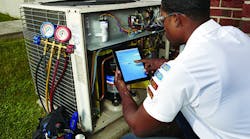Imagine this: You’re not feeling well, so you schedule a doctor’s appointment to get checked out. When you arrive they take your insurance card and co-pay (of course). Then they whisk you past the infamous station where they usually take your blood pressure, temperature, and, weight. Instead they immediately sit you in the visiting room and tell you the doctor will be in shortly.
Your doctor enters the room, takes a quick look at you, asks you how you’re feeling, then hands you a stack of prescriptions for new medications he can’t even pronounce, and schedules an appointment with an Oncologist, orders an MRI and a CAT scan – just to be on the safe side, and sends you on your way.
Most technicians immediately go down their maintenance task list replacing filters, vacuuming equipment, checking blower wheels, contactors, and electrical connections – without ever taking the system’s vitals
How comfortable do you feel with that scenario? Think about it, isn’t that what the majority of HVAC service technicians do every day in their customers’ homes? On service calls, most spend a few minutes with the customer to find out what the problem is, then they typically go right to the area that’s not working, and begin troubleshooting the problem.
Most technicians never stop to take the blood pressure and key temperature of the entire system (at the equipment and the circulatory system, i.e. duct system) before they start trying to diagnose the “patient.” They might check refrigerant charge, or troubleshoot the controls, but usually don’t stop to take vitals first – unfortunately, most are never trained on how to do this.
Maintenance calls are even worse. Most technicians immediately go down their maintenance task list replacing filters, vacuuming equipment, checking blower wheels, contactors, and electrical connections – without ever taking the system’s vitals.
If You Don’t Measure, You’re Just Guessing
While the normal maintenance tasks are important, the knowledge your technicians gain by first taking the system’s vitals will make their work much faster and more accurate. For example, by testing static pressures, they can tell if the right amount of air is making it through the equipment to deliver the right BTUs through the coil or heat exchanger.
When they measure temperatures at key points in the system, they can determine if the cooling or heating BTUs are there to begin with and if the “circulatory system” is allowing those BTUs to reach the occupied space. It’s that simple.
Another great reason to take a system’s vital signs before “operating” on it, is to uncover issues before you start performing the maintenance work. With this knowledge you can approach the customer and explain that you’ve found some issues with their system and would like their permission to proceed with diagnosing what is going on.
This helps reduce the liability associated with the “It was fine before you worked on it,” claim that frequently occurs when you don’t test before you service their equipment.
Another huge benefit of measuring basic vitals is that your technicians will likely uncover performance issues on seven of 10 systems they service or maintain. On average, the typical HVAC system is only performing at 57 percent delivered capacity at the registers and grills.
Think of all the new leads for opportunities to help make your customers’ homes and HVAC systems safer, healthier, more comfortable and energy efficient.
Start Testing And You’ll be Amazed At What You Find!
So before you touch that next system, be sure to check its vital signs first. The key is consistency and making initial testing mandatory on every service call – as well as new installations.
Not sure how to test an HVAC systems vitals? Start with measuring and comparing Total External Static Pressure (TESP) to nameplate data. NCI has a basic static pressure testing procedure available online at no cost to get you started.
Visit whypbc.com to learn more.
So, there are no excuses. Increase your business’ value as a professional HVAC service company by learning how to take your “patients’” vital signs today.
Dominick Guarino is CEO of National Comfort Institute (NCI), one of the nation’s premier Performance-BasedTM training, certification, and membership organization, focused on helping contractors grow and become more profitable. His e-mail is [email protected]. For more info on Performance-Based ContractingT™ go to WhyPBC.com or call NCI at 800/633-7058.










